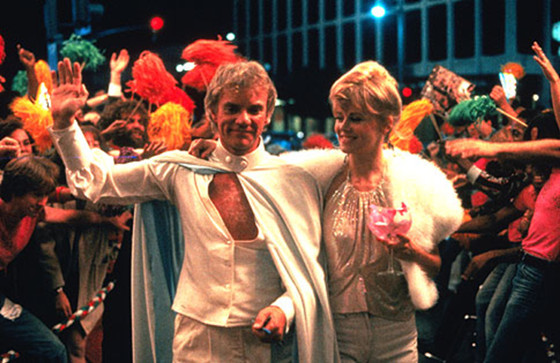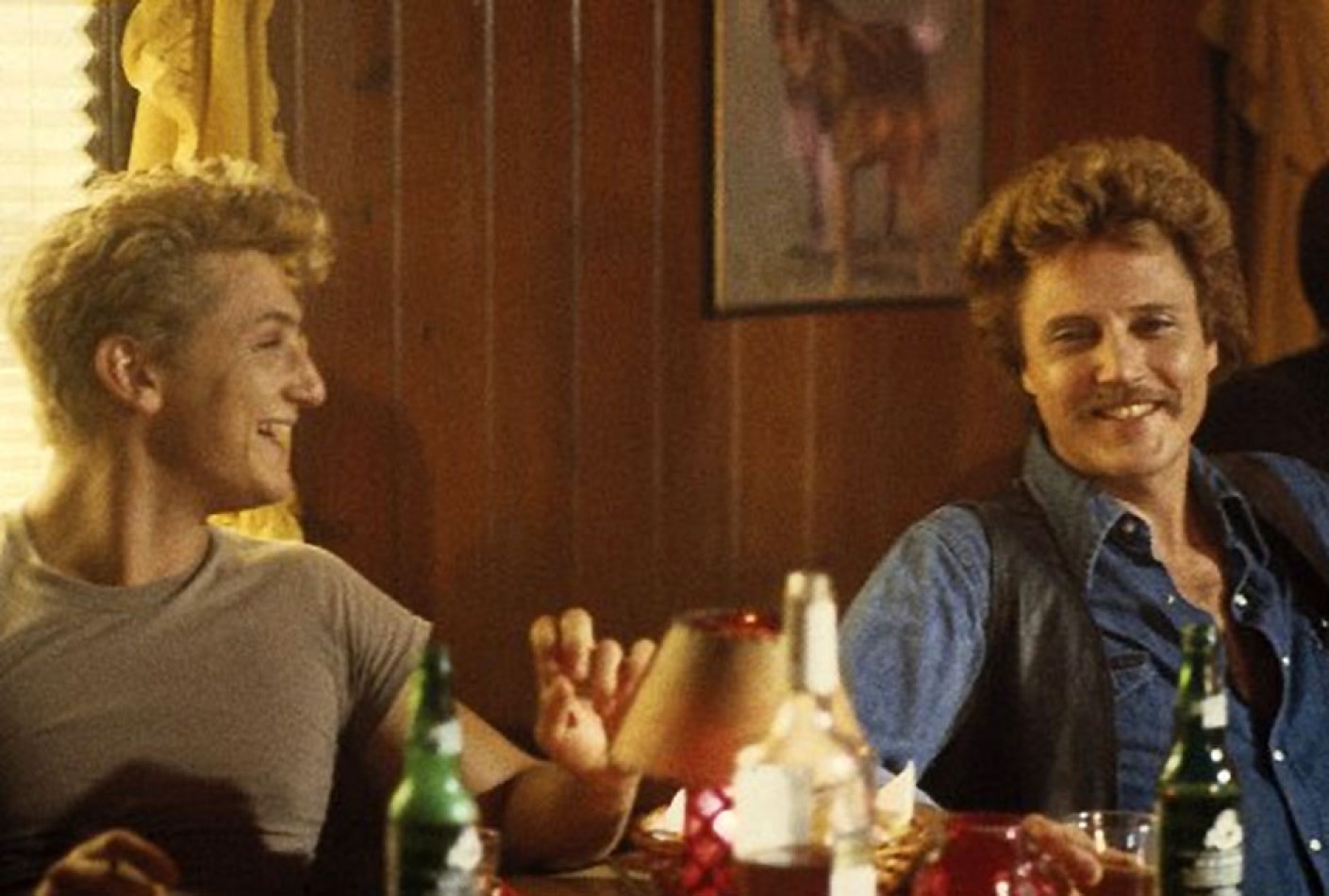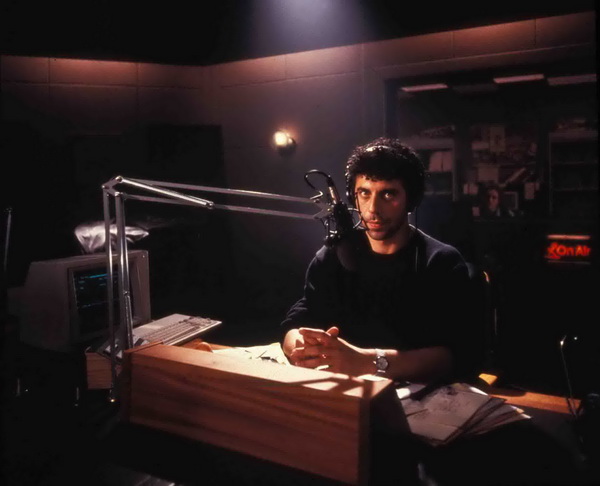6. Get Crazy (1983)

Get Crazy is one of the most insane American comedies of the 1980s, the kind of film that really isn’t all that great but is definitely a lot of fun. It’s also one of those typically zany films which veers over into truly mad territory, and quite simply has to be seen to be believed.
Daniel Stern plays a promoter who is putting on what he hopes will be the best New Year’s Eve concert ever. He invites Auden (Lou Reed), an obvious parody of Dylan, to headline. Naturally, he agrees to play and sets off to the concert, though he arrives late and misses the whole gig – and most of the film for that matter. He also enlists Piggy, a violent punk rocker, and the Mick Jagger-esque rock god poser, Reggie Wanker (Malcolm McDowell). Cue lots of loud music, daft gags, and ludicrous shenanigans.
Get Crazy includes a man who is in fact a giant spliff, a robot drug dealer, a poster that has a live tongue trying to lick a girl from her bedroom wall, and McDowell talking to his own penis – which then answers him. Stern makes for a good sane leading man, keeping grounded amidst the mayhem, while reliable staples like Allen Garfield and Ed Begley Jr are stand outs in the supporting cast. But McDowell steals the show. His likeness to Jagger is at times dangerously close; all pouts, posture and posing, the Stones front man was obviously an inspiration for the role. Incidentally he turns out to be a good singer, belting out a terrific version of Hoochie Koochie Man.
Malcolm later said of the film: “They can’t all be masterpieces. I had fun and that’s the main thing,” Indeed, it’s no masterpiece, but it is a lot of fun. Not so easy to find these days, old VHS and DVD copies may prove tricky to track down (maybe expensive too), but Get Crazy is worth the detective work. A lost treasure, totally harmless but also totally mad, too.
7. At Close Range (1986)

Another rare mid 80s film is At Close Range, a riveting drama which is unjustly out of print these days and deserves a fresh new release. Directed by James Foley, it’s probably more known now for being the film which plays throughout Madonna’s Live to Tell music video.
Based on true events, it stars Christopher Walken as Brad Whitewood Sr, head of a crime family in Pennsylvania, whose son Brad Jr (Sean Penn) has been living with his mother and grandma in a run-down part of town. When he goes to stay with his dad, Brad Jr sees the life his father lives, the money and the flash car he shows off, and vows to join him in a vain attempt to make a better life for himself and his family. With his brother Tommy (Chris Penn), Little Brad starts his own gang, and them expresses a wish to join his father’s organisation. When he witnesses a mob killing however, he changes his mind, and the FBI arrive in hopes that Brad Jr will inform on his father’s crime syndicate.
At Close Range was a box office disappointment upon release, odd considering Penn and Madonna’s huge profiles at the time (they were, of course, married in those days), but understandable when you think of how far the film was from the feel-good hits of the era. But At Close Range is a wholly compelling fable. Directed wonderfully by the underrated Foley, Nicholas Kazan’s screenplay is both thoughtful and provocative, a tale of a father and a son trying to connect and build bridges in the most difficult of circumstances. Penn and Walken carry the film with their fine performances, but everything else works so well as a whole that you never see the acting. Instead you get carried along by the story and the various obstacles which arise along the way.
8. Talk Radio (1988)

Of all the post-1986 films directed by Oliver Stone, Talk Radio, based on Eric Bogosian’s play, is certainly one of the most overlooked.
The film stars Eric Bogosian as Barry Champlain, a popular radio shock jock in Texas. He uses provocative language, insults his callers, even when they like him, tackles controversial subjects such as racial friction, and dares to go where no other radio star has gone before. Though a hit in Dallas, we learn early on that Barry’s show is just about to go nationwide, which means naturally that fame and a wider recognition awaits him. The first half of the film explores Barry’s flippant, almost careless approach to the public who ring into his show, the narcissistic way he puts them down and degrades them for cheap laughs.
John C McGinley plays Stu, his loyal call-screener, who laughs along with some of Barry’s worst slurs. When a sinister caller rings up and subsequently sends in a package he swears on-air is a bomb, Barry shrugs off the threats. Opening the box, he finds a dead rat inside. It’s not a bomb, granted, but it’s definitely a message. Barry is dating his producer, Laura (Leslie Hope), but still has a connection to his ex-wife, Ellen (Ellen Greene), who is on her way to Dallas to witness his “final” local show the following night. And when the night arrives, Barry realises he is more alone than ever, alienated in his booth, questioning the fact that he is a man who, when all is said and done, insults people for a living. And as the clock ticks on, it is revealed that some of the threats that have come Barry’s way were not empty after all. It is then the drama and upheaval we have witnessed in the previous 90 minutes comes to a devastating head.
The stage production of Eric Bogosian’s Talk Radio had been a smash hit in 1987, beginning its off-Broadway run in May at the Public Theater under the direction of Frederick Zollo. Oliver Stone had seen the play and loved it. He worked on the screenplay with Eric, enhancing the one act play into a three sectioned movie, with a flashback segment in the middle that explored more of Barry’s past life as a suit salesman, as well as his relationship with his ex-wife, Ellen. The essential message of the play, and the fire that keeps it burning along, remained intact, but Stone knew he had to make it more cinematic, give it more scope so that there was an added punch to the final section.
Naturally, Eric himself ended up playing Barry Champlain. After all, it was his play, and there was no one else who understood the material, and indeed the character, the way Eric did. He delivers an enthralling, high energy, high octane performance, a brave and daring piece of work from the first moment we hear his voice coming over the airwaves. The rest of the cast are perfect too. Alec Baldwin is great as the slick, slimy face of the network, doing the best he can to make sure Barry’s deal goes ahead and both of them get a nice hefty pay day.
For anyone wanting to know what makes Oliver Stone such a strong director, Talk Radio is an ideal starting point. Given that most of the film takes place in one room, right there in the studio (save the flashbacks of course), Stone had a challenge on his hands to make sure the viewers didn’t find their attention spans drifting. If anything, the fact we are trapped in one location, hermetically sealed with the riffing shock jock and his sweaty team of helpers and corporate stiffs, makes the film all the more tense, suffocating, and claustrophobic.
Sadly, Talk Radio didn’t perform well at the box office, barely making back its budget in ticket sales. Reviews were good, but the film sank and soon disappeared from people’s minds. Which is a shame indeed, because I think it’s a fantastic movie, very much an experience, a rough and ready ride all the way through.
9. The Rosary Murders (1987)

The Rosary Murders is a no-frills but highly compelling thriller which has become totally obscure these days. With a screenplay co-written by Elmore Leonard, adapted from William X Kienzie’s book, it’s a lesson in how to make a good murder mystery without resorting to cheap tactics and eye-rolling familiarities. It stars Donald Sutherland as Father Koesler, a man trying to keep his head amidst a series of brutal church-related killings he is determined to get to the bottom of.
Directed by Fred Walton, The Rosary Murders looks like it could a so-so by the numbers pot boiler – at least on paper. As soon as the film begins, however, it is instantly gripping. There’s a subtlety to the whole thing which makes it a cut above your average thriller, and the writing is particularly polished.
The cast, too, are at the top of their game. The ever reliable Charles Durning puts his usual charm into proceedings, nailing his role as Father Nabors. That said, it’s Sutherland who carries the film. Again, he is not “acting” in the manner that many more showy performers do. There is an almost zen-like quality to the way he puts himself into the shoes of Father Koesler while helping the story go from A to B. This sounds overly methodical, but what Sutherland does is straight forward in the way that he uses himself as a tool in order for the filmmaker to resolve their story. There is a focus to the work, as there always is when he is the lead in a mystery story (think Don’t Look Now and Invasion of the Body Snatchers), so that he serves the picture rather than acts all over it.
The Rosary Murders may not be everyone’s cup of tea, but fans of well written and subtly acted murder mysteries will be most engrossed. It’s also fun to look for a young Jack White, who appears very briefly as an altar boy.
10. The Hand (1981)

The Hand tells the story of Jon Lansdale (Michael Caine), a comic book illustrator who works on a Conan-esque character as his day job. He is married to Anne (Andrea Marcovicci) and has a daughter, Lizzie (Mara Hobel), but their home is not the most happy one. One day when Anne and Jon are out in the car having an argument, a confusing and somewhat aggressive ruckus on the road with other vehicles leads to Jon putting his arm out of the window, and having it severed form his body in a bloody and traumatising manner.
Now, Jon has to live without his drawing hand, something he struggles with from the word go. Worse still, his hand was never found. When he starts to show signs of a mental breakdown, scribbling over the hard work of an artist whose project he was asked to co-produce, he is fired, and begins to wonder if he might have performed the act in the heat of a jealous blackout. Jon moves to California to teach art at a small college. Renting a cabin in the woods, Anne tells him that she and Lizzie won’t be joining him for a while. Annoyed, he begins an affair with a student named Stella (Annie McEnroe), only this turns troublesome once he realises Stella has another lover, Brian (Bruce McGill), a man Jon knows from the local bar. Inevitably, the hand intervenes. All this leads up to the arrival of Anne and Lizzie, though the perfect family reunion Jon might have hoped for does not take place. The more into the film we get, the more disturbed Jon becomes, and the more brutal is the wrath of the hand.
This was Oliver Stone’s first directorial film after the success of Midnight Express, the screenplay of which won him an Oscar in 1978. Stone initially wanted to work on the prison drama Baby Boy, but instead chose to adapt Marc Brandel’s novel, The Lizard’s Tail, which was about a cartoonist whose lost appendage starts to act out evil deeds on his behalf. Stone retitled it The Hand, much catchier it has to be said, giving the viewer the chance to figure out whether the main character was performing the acts himself, or if it really was the hand acting independently. Stone wanted it more psychological, for the hand to symbolise Jon’s toxicity, while the production company, Orion, wanted, in Stone’s words, “more hand.” In the end, they got what they wanted. Though the film would indeed remain psychological, there are plenty of images of the hand itself moving across the floor, gripping onto throats and inanimate objects alike.
Sadly, The Hand was not a hit for Oliver, and was regarded as a silly film by some. In my view, however, The Hand is unfairly underrated, not just by cineastes and critics, but by its writer and director as well. Granted, it is a mile away from the more humanly concerned films he would go on to make from 1986 onwards, but it’s a fascinating character study, unflinchingly dark, tormented and demented, a twisted fable of jealousy, possessiveness, and self-hatred. Stone’s direction is assured, note perfect for every mood the film goes through.
Caine’s performance is also splendid, a disturbing effort from the great man that for me ranks as one of his most unfairly under-appreciated portrayals. A remarkably versatile actor, Caine can play Jack the lads, stuck up officers, rough diamonds, fusty professors, and vengeful pensioners. Here, he embodies the dangerously jealous male to a tee, a perfect personification of the potential darkness of the human soul. Caine later wrote in his memoir, From the Elephant to Hollywood, that though he and Oliver would admit The Hand was neither of their best moments, he added that Stone was a genius.
To Oliver Stone, the movie was more about one man’s descent into madness, a personal downfall into an abyss, than a chance to have cinema-goers screaming in their seats. Today the film has a loyal cult following, but in my view should attract a lot more praise than it currently does. It’s time to dust this one off…